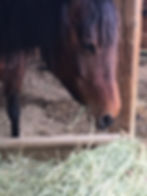10 Reasons to Buy Teff Hay for Horses
- Natalie Sullivan, MS PAS
- Jan 11, 2021
- 4 min read
Updated: Dec 30, 2023
I love forages. As an equine nutrition consultant for nearly 15 years, I have a handful of mantras that I share with horse owners at every opportunity. One such mantra is “solve problems with forage first”. Most horses are fed proportionally far more forage than feed or supplements yet the solutions are often proportionally reversed. Many sorts of digestive, endocrine or muscle problems (i.e. chronic colic, metabolic disease, PSSM, allergies) may be improved by an appropriate adjustment to the nutritional base- the hay or pasture that you provide. I would suggest hiring a nutrition consultant first about possible forage changes. Teff hay may be one such forage option to try.

Teff hay is not just for carb sensitive, easy keepers! Yes, it’s most often recommended as an ideal forage for horses at risk for laminitis (when grown and harvested under the right conditions), but all horse owners can and should consider teff hay as a primary forage. I, myself, have been feeding this lovely grass species for three years now to my eventing mare, an easy-keeping quarter horse and a warmblood cross filly.
THE LIST
1.GOOD PROTEIN and ENERGY VALUES: Protein and energy values are appropriate for a wide range of needs. Good quality teff hay should range between 11-13% protein and 0.9-0.95 Megacalories per pound (DE). Sound familiar? It should. Timothy grass tends to have the same values. Actually, out of all the grasses, I would compare teff to timothy as the most similar in nutritive values.
2. LOWER AVERAGE NON-STRUCTURAL CARBOHYDRATES: Teff grass is what plant biologists call a C4 grass. What this means is that it has a very different metabolism compared to the C3 grasses that horse owners are most familiar with (i.e. timothy, orchardgrass, and fescues). The C4 grasses like teff will metabolize and store energy as carbohydrates differently than their C3 counterparts. Long story short, teff grass ON AVERAGE will have fewer of those pesky non-structural carbohydrates compared to other grasses when grown under the right conditions. Now, this is not a hard, fast rule and won’t hold up in court. So, you must still test your teff hay if your prerogative is indeed a low-carb diet. But if we all had a $100 bucks to gamble, we’d put our money on the teff.

3. FIBER: Why does my hometown of Ellensburg export so much timothy hay? Fiber- that’s why. Though we might not post handsome photos of timothy haystacks with memes like “your fiber profile is perfect for my horse”, this is indeed a reason that we love to feed timothy to horses. Well, why is this relevant to teff hay? Because, teff hay too is high in complex fiber and great for horses in light to moderate work (and this is most of us not not working at the top level of equine exertion 6 days a week). If your horse has chronic diarrhea problems, I will often recommend higher fiber forages like teff to clean up the mess.
4. HYPOALLERGENIC: If you, your family member, your barn feeder or your horse gets hives every time they come near a bale of timothy or alfalfa, you may want to consider teff. Think of teff like those alternative dog foods with kangaroo or buffalo meat rather than lamb or chicken. I actually have a personal story to showcase this. I was boarding my mare at a friend’s house where the husband who often fed was allergic to timothy. Living in timothy country, this made it difficult to source hay. However, teff hay was just the ticket for my easy-keeper quarter horse mare and and the itchy, sneezing husband!
5. ANCIENT GRAIN: Teff grass is an ancient grain from the African country of Ethiopia. In it’s native homeland, teff grass is actually grown for the seed. The harvested teff seed is ground and made into a large crepe like staple food called injera. So, if you’re into the Paleo diet, you can now offer the same to your horse.
6. PALATABLE: You would think that being a lower carb forage that teff would be relatively unpalatable. However, given it’s very fine, soft stems horses more often than not love it! There are only a few reasons why your horse may NOT like teff. First, the crop may have been cut too mature indicated by a plethora of seed heads. Secondly, your horse has been spoiled with high carb forages and/or alfalfa and needs time to adjust.

7. ENVIRONMENTALLY FRIENDLY: The production of teff hay is generally less intensive than other types of forages. For starters, teff requires only a moderate amount of fertilizer to thrive. In addition, the species is drought tolerant and actually prefers the intense heat of mid summer months. This makes it a unique option for farmers in need of summer annuals to incorporate into holistic farm programs. Lastly, the teff plant will die with the first frost therefore no chemicals are necessary to eliminate it from a field.
8. NON-GMO: I have not yet come across a GMO teff seed, though I can’t swear that they don’t exist. There are no Round-Up Ready teff seeds.
9. NO KNOWN TOXINS: Some forages carry with them intrinsic risks such as mycotoxins and nitrates. For example, we don’t typically feed oat hay or sudan grass to horses due to the potential for these crops to accumulate nitrates under stress. Teff grass does not typically accumulate nitrates or have any known mycotoxin problems that would be high risk for horses.
10. NOW EASIER TO FIND: The Low Carb Horse Hay Certification program has two objectives; 1) Increase the supply of high quality, low carb teff and 2) Increase the demand for teff hay so that more farmers will grow it.

